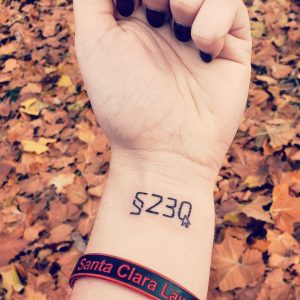Snapchat’s Speed Filter Protected by Section 230–Lemmon v. Snap
 This case involves a fatal crash after the car occupants used Snapchat’s speed filter to record going 123 mph. Snapchat defended the subsequent personal injury lawsuit on Section 230 grounds. The court previously dismissed the case with leave to amend. This time, the court dismisses with prejudice.
This case involves a fatal crash after the car occupants used Snapchat’s speed filter to record going 123 mph. Snapchat defended the subsequent personal injury lawsuit on Section 230 grounds. The court previously dismissed the case with leave to amend. This time, the court dismisses with prejudice.
The central contested issue is whether the claim relates to third-party information. The court says:
the Court cannot simply presume that the Speed Filter is “content” because Plaintiffs allege that it is; rather, the Court must determine whether the Speed Filter is a “content-neutral tool” or “content.”
Ugh. The term “content-neutral tool” is so problematic. Still, the court says that’s what the Speed Filter is:
the Speed Filter is a neutral tool, which can be utilized for both proper and improper purposes. The Speed Filter is essentially a speedometer tool, which allows Defendant’s users to capture and share their speeds with others. The Speed Filter can be used at low or high speeds, and Defendant does not require any user to Snap a high speed. While Plaintiffs allege that some users believe that they will be rewarded by recording a 100-MPH or faster Snap, they do not allege that Snap actually rewards its users for doing so. In fact, when a user first opens the Speed Filter, a warning appears on the app stating “Please, DO NOT Snap and drive.” When a user’s speed exceeds 15 m.p.h., another similar warning appears on the app. While a user might use the Speed Filter to Snap a high number, the selection of this content (or number) appears to be entirely left to the user, and based on the warnings, capturing the speed while driving is in fact discouraged by Defendant….
The Court cannot ignore the fact that the content itself, the 100-MPH-Snap (or other high-speed Snaps) is at the crux of Plaintiffs’ claims. In other words, despite Plaintiffs’ assertions to the contrary, it appears that Plaintiffs are seeking to hold Defendant responsible for failing to regulate what the users post through the Speed Filter; if the users were not motivated to capture their high speeds for content, they would not speed.
The court made a powerful, but logical, move. The Speed Filter is a content creation tool. It doesn’t publish content until users populate it with their content. So imposing liability for making the content creation tool available would ultimately hold Snapchat liable for third-party content. Stated that way, of course Section 230 applies.
Still, I understand why this vexes the plaintiffs. The plaintiffs are claiming that Snapchat’s content creation tool encouraged its users to do dangerous things to create their content. I’m sympathetic to this concern. The court implies that Snapchat users might choose to post a low-MPH snap. Sure, in theory, but really? Anyone who thought about it for a half-second would know that the Speed Filter would primarily motivate snaps at high speeds. I’d love to know what Snapchat thought about that risk when rolling out the tool, and what additional design considerations they discarded that might have discouraged dangerous behavior. The court’s response–that the tool worked for both high- and low-MPH snaps–is technically accurate but glosses over the practical effects.
Then again, if this argument against the Speed Filter worked, eventually every plaintiff would argue that the Internet service’s tool somehow motivated users to engage in tortious or criminal behavior as part of the content creation process. There’s no natural boundary to that argument. That’s why the “content-neutral tool” terminology, as bad as it is, helps courts establish a border.
To bolster its conclusion, the court rejects some of the plaintiffs’ arguments:
- “the Court cannot meaningfully distinguish the situation here from other cases, which have similarly rejected the plaintiff’s efforts to plead around the CDA requirement by alleging that the website’s features promoted the users to engage in illegal conduct.” Cites to Doe v. Backpage and Roommates.com.
- Citing Doe II v. MySpace, “even though the plaintiffs there were harmed offline when they were sexually assaulted by people they met through the website, the court held that CDA immunity applied. Similarly, the Court concludes that CDA immunity applies even if Plaintiffs here were harmed by the users’ conduct of speeding.”
- Citing Roommates.com, “the Court cannot conclude that ‘it is very clear’ that the Defendant ‘directly participated’ in developing the alleged illegality. For example, Plaintiffs do not allege that Defendant asked its users to capture a Snap with a high speed or even suggested that they should do so. Instead, Plaintiffs’ allegations appear to amount to “enhancement by implication or development by inference” – that the Speed Filter impliedly suggested to users that they should Snap a 100-MPH-Snap. However, in such a close scenario, the Ninth Circuit has held that section 230 immunity applies.”
- The court distinguishes Maynard v. Snapchat for not applying the Ninth Circuit’s “neutral tools” standard.
This is a heartbreaking case, but the judge did a meticulous job parsing the technology and the precedent. For that reason, I think this ruling is persuasive and has a good chance surviving an appeal.
Case citation: Lemmon v. Snap, Inc., 2020 WL 913643 (C.D. Cal. Feb. 25, 2020)

Pingback: News of the Week; March 4, 2020 – Communications Law at Allard Hall()